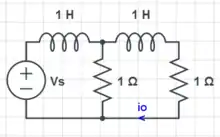
Given that Vs = (1 + 2t)μ(t), find io using the convolution integral.
Transfer function
simplify((1/(1+s))/((s+1/(1+1/(1+s)))*(1 + 1/(1 + s))))
solve(s^2 + 3*s + 1,s)
Homogeneous Solution
Two real, different roots:
So Io has this form:
Particular Solution
After a very long time, inductors are shorts, the voltage across both 1 ohm resistors is 1 volt, so io is 1 amp:
Initial Conditions
Adding the particular and homogeneous solutions together, have this form:
After a long period of time (using the particular initial condition again), the current is going to be 1:
Initially, the two inductors are going to be opens, thus io has to be 0:
Initially, all the drop is going to be across the first inductor, leaving the voltage across the second zero. The current io flows through both the second inductor and it's serial resistor, so an equation for this voltage can be obtained by taking the derivative:
solve([1+A+B,s1*A + s2*B],[A,B])
So:
Impulse Solution
Taking the derivative of the above get:
Convolution Integral
syms t x s1 = (-3 + sqrt(5))/2; s2 = (-3 - sqrt(5))/2; f = (s1*s2/(s1-s2)*(exp(s1*(t-x))-exp(s2*(t-x)))*(1+2*x)); S =int(f,0,t); vpa(S, 3)
At t=0:
Which means that C_1 = 0 so finally: